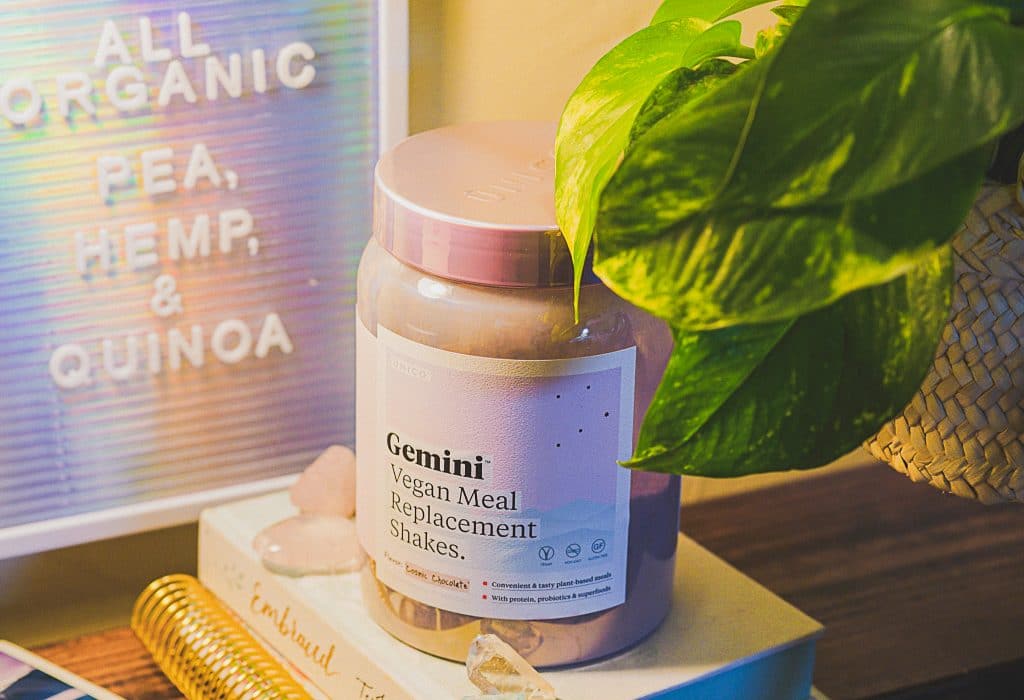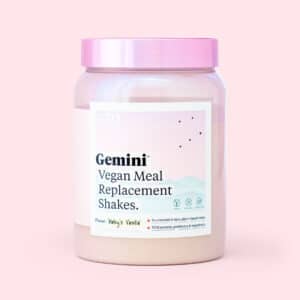Vegan protein complementation is the practice of combining different vegan protein sources in order to achieve a more balanced, or nutrient-dense end product. In this post we will go over how to combine vegan proteins with the goal of getting complete proteins in your diet.

Protein Complementation. Whew. It sounds complicated, doesn’t it?
“Ladies and gentleman, welcome to the art of complementation. In your first class, we’re going to turn this textbook into a frog!”
You can almost hear <insert your favorite Hogwarts Professor here> declaring loudly at the beginning of class…
Alas, no. There will be no hopping creatures involved here (well, unless you are using severely under-processed cricket protein!) (yes, it’s a real thing unfortunately!).
But there WILL be some magic.

The magic of protein complementation lies in combining various vegan protein powders to create an end product that is nutritionally superior to that of its individual constituents. Often times, complementation is done with the intention of mimicking one of the higher quality* dairy proteins.
*for the purposes of this article, we are judging amino acid quality (completeness and density) – although of course ‘quality’ could encompass calorie & macronutrient composition, lactate, etc.
Protein Complementation: pairing different vegan protein sources in order to achieve a more balanced, or nutrient-dense end product.
Let’s start our journey into vegan protein pairing by looking at the typical amino acid composition of whey protein: (all amounts shown in mg / g)
Whey Protein Amino Acid Composition:
| Amino Acid | mg / g |
| Leucine | 105 mg |
| Lysine | 93 mg |
| Tyrosine | 32 mg |
| Cysteine* | 21 mg |
| Isoleucine | 63 mg |
| Valine | 58 mg |
| Threonine | 69 mg |
| Tryptophan | 18 mg |
| Histidine | 17 mg |
| Methionine* | 32 mg |
As you can see, whey protein is extremely high in Leucine – one of the most important essential amino acids. Leucine is also in fact one of the branch-chain amino acids (more on the difference between EAAs and BCAAs here).
Because whey, and most of the dairy proteins contain all 9 EAAs, they are used commonly by athletes to rebuild muscle, and by anyone looking to add quality protein in their diet.
Vegan Protein Complementation
Historically, all protein powders have been dairy-based because of its nutritional value, reasonable cost, and relatively neutral taste.
In the past decade, emerging agricultural technology has allowed for vegan proteins to be extracted and sold as supplements – giving consumers an entirely new category of protein powder.
Because most vegan proteins are deficient in at least one essential amino acid, it is important to combine them with other vegan proteins with complementary amino acid profiles.
Let’s look at a few amino profiles of the most common types of vegan proteins, and then we’ll go over the most popular vegan protein pairing strategies:
Yellow Pea Protein Amino Acid Profile:
| Amino Acid | mg / g |
| Leucine | 70 mg |
| Lysine | 65 mg |
| Tyrosine | 31 mg |
| Cysteine* | 5 mg |
| Isoleucine | 41 mg |
| Valine | 44 mg |
| Threonine | 30 mg |
| Tryptophan | 8 mg |
| Histidine | 20 mg |
| Methionine* | 8 mg |
Looking at the table of amino acids in pea protein, a few key differences from the whey profile are immediately noticeable.
The most glaring difference between dairy and pea protein, from an amino acid standpoint, is in the SAA, or ‘sulfur amino acids’.
Whey contains almost 5x more cysteine, and 4x more methionine.
While methionine is both an SAA and an EAA, cysteine is not considered an EAA, because our body can make it on it’s own. However, both cysteine and methionine are considered critically important to our overall health, as they play critical roles in our immune, cardiovascular, and endocrine systems.5
In addition to the SAA-content of pea protein being much lower than in whey protein, the BCAA content, is also about 30% lower – making it a less attractive choice for athletes.
Or is it?
A study in 2015 conducted in Dijon, France (yes, like the mustard), actually found that a certain brand of pea protein that was ‘particularly high in branch chain amino acids’ increased the biceps size of participants as much as whey protein.4
So, is pea protein as effective as whey protein at building muscle? More research is likely needed, as it is unclear whether the pea protein used in the study was specialized or represented a common pea protein you would find in the store.
While pea may still be behind whey when it comes to amino completeness, it is considered the best vegan protein source, and is the basis for almost all modern day complementation strategies.
But before we talk strategy, let’s look at a few other vegan protein sources, and their amino profiles:
Brown Rice Protein Amino Acid Profile:
| Amino Acid | mg / g |
| Leucine | 63 mg |
| Lysine | 23 mg |
| Tyrosine | 42 mg |
| Cysteine* | 17 mg |
| Isoleucine | 33 mg |
| Valine | 43 mg |
| Threonine | 30 mg |
| Tryptophan | 12 mg |
| Histidine | 17 mg |
| Methionine* | 23 mg |
Brown rice is one of the most common vegan proteins and it does contain more of the SAAs than pea protein, but it is still used less frequently than pea for three reasons:
- First, it is incredibly low in the amino acid Lysine – with only 1/3 the amount found in pea, and 1/5 the amount found in whey. Lysine is an important pre-cursor to carnitine, which helps us metabolize fat effectively. Lysine is therefore a critical nutrient to any weight loss program- making brown rice a poor choice for those looking to slim down.
- Second- brown rice has a slightly lower in BCAA (branch-chain amino acids) than pea protein. With less leucine, isoleucine, and valine per gram than other popular vegan protein sources, brown rice falls short when it comes to helping build and maintain lean muscle.
- Lastly, brown rice is not a gel-forming protein, and it has a distinct ‘chalky’ taste when drinking. While these reasons are less important than the two relating to its nutritional value, it is a big part of why brown rice is used less and less these days.
Hemp Protein Amino Acid Content:
| Amino Acid | mg / g |
| Leucine | 63 mg |
| Lysine | 39 mg |
| Tyrosine | 35 mg |
| Cysteine* | 20 mg |
| Isoleucine | 28 mg |
| Valine | 38 mg |
| Threonine | 37 mg |
| Tryptophan | 9 mg |
| Histidine | 32 mg |
| Methionine* | 23 mg |
Hemp is becoming increasingly popular as hemp-derived ‘CBD’ products continue to garner attention in the health/wellness community.
While cannabidiol is a topic for another day, it is the protein content of hemp that we’re interested in today- and what an interesting protein it is!
Packed with naturally-occurring fibers, and healthy fats like GLA6 , hemp has similar BCAA content to brown rice (so still less BCAA than pea), but does not suffer from the low lysine problem that brown rice has. Hemp also boasts the highest histidine content of any of the vegan protein sources.
Hemp also has slightly more SAA than brown rice, and a more neutral flavor and taste to boot.
Quinoa Protein Amino Acid Content:
| Amino Acid | mg / g |
| Leucine | 70 mg |
| Lysine | 70 mg |
| Tyrosine | 41 mg |
| Cysteine* | 15 mg |
| Isoleucine | 48 mg |
| Valine | 57 mg |
| Threonine | 37 mg |
| Tryptophan | 9 mg |
| Histidine | 36 mg |
| Methionine* | 31 mg |
Quinoa is a well-known superfood, and is considered one of the best vegan protein sources.
Quinoa protein is high in branch chain aminos, and is the best source of naturally-occurring lysine of any plant-based protein source!
along with magnesium, riboflavin, and other micronutrients, quinoa makes for an excellent addition to any vegan protein blend.
Complementation Strategy 1: Pea + Brown Rice
The most popular way to combine vegan proteins is by blending pea protein with brown rice.
PROS: The brown rice has complementary SAAs that the pea is missing, while the pea has plenty of lysine to cover for the brown rice. Brown rice is also a highly cost-effective protein, which means most pea + rice mixes are relatively affordable.
CONS: Brown rice often yields a ‘chalky’ taste and texture, and you don’t get as broad a range of micronutrients
Complementation Strategy 2: Pea + Hemp + Quinoa
A less popular, but superior way to arrange a highly complementary vegan protein is by using pea, hemp, and quinoa.
PROS: Three sources highest in BCAA, highest in SAA, and with naturally-occurring healthy fats and fibers. Quinoa provides plenty of SAAs and Lysine. Hemp provides healthy fats, fibers, and BCAAs.
CONS: Hemp is the most expensive of all plant-based proteins. Blends using hemp are often more expensive than those using rice.
Summary:
Today we learned all about why combining vegan protein sources is important.
Because different plant-based proteins have unique, and varied nutrient compositions, it is advantageous to combine several plant-based proteins to achieve a nutritionally optimized end product.
Our Vegan Meal Replacement Shakes are an excellent example of plant-based protein complementation in practice – boasting 18 grams of high quality protein from a combination of organic pea, organic hemp, and organic quinoa protein sources.
Sources:
1https://www.openfit.com/complementary-proteins
2https://www.ncbi.nlm.nih.gov/pmc/articles/PMC6245118/
3https://www.sciencedirect.com/topics/agricultural-and-biological-sciences/sulfur-amino-acids
4https://jissn.biomedcentral.com/articles/10.1186/s12970-014-0064-5
5https://www.healthline.com/nutrition/methionine
6https://link.springer.com/article/10.1007/s10681-004-4811-6
Recommended Reading:
- Holiday ‘Jingle Balls’ – A Festive Take on No-Bake Protein Balls - December 20, 2023
- Cryptic Cold Brew – A Must-Try for the Most Mischievous - October 31, 2023
- Does Protein Powder Make You Gain Weight? - October 4, 2022

